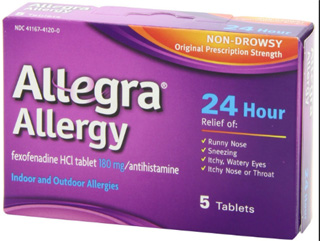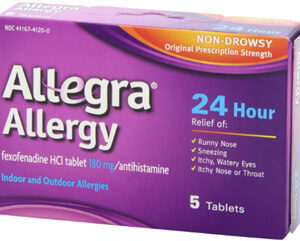Allegra Medication Overview
Allegra is the brand name for the drug fexofenadine hydrochloride, an antihistamine used to alleviate the symptoms associated with seasonal allergic rhinitis and urticaria (hives). It operates by blocking histamine-1 (H1) receptors to prevent the effects of histamine, a substance released during allergic reactions.
Available Dosage Forms
Allegra is available in various forms including tablets, orally disintegrating tablets (ODT), and oral suspension. Tablets come in 30 mg, 60 mg, and 180 mg strengths. The ODT formulation is available in a 30 mg dosage, and the oral suspension has a concentration of 30 mg per 5 mL.
Therapeutic Indications
Allegra is indicated for the relief of symptoms associated with seasonal allergic rhinitis in patients 2 years of age and older. It is also indicated for the treatment of chronic idiopathic urticaria in patients 6 months of age and older.
Administration Guidelines
Allegra tablets and ODT should be taken with water and can be administered with or without food. However, the absorption of fexofenadine may be reduced if taken with high-fat meals or with fruit juices such as apple, orange, or grapefruit. The oral suspension should be shaken well before use, and an appropriate measuring device should be used for dosing.
Recommended Dosage Regimen
For seasonal allergic rhinitis, the recommended dose for adults and children 12 years and older is 60 mg twice daily or 180 mg once daily. Children 2 to 11 years should receive 30 mg twice daily. In treating chronic idiopathic urticaria, the same dosage regimen applies.
Dose Modifications
Patients with kidney impairment may require dose adjustment. For patients with a creatinine clearance rate less than 80 mL/min, the starting dose should be reduced to 60 mg once daily. Patients undergoing dialysis should avoid Allegra, as it is not effectively removed by hemodialysis. No dosage adjustment is necessary for patients with hepatic impairment.
Pharmacokinetic Profile
Fexofenadine has a bioavailability of approximately 30 to 41% and is not extensively metabolized by the liver. It does not appear to cross the blood-brain barrier significantly. The peak plasma concentration is reached within 1 to 3 hours after oral administration. Fexofenadine has an elimination half-life of 14.4 hours in healthy adults and is primarily excreted unchanged in the feces and urine.
Potential Drug Interactions
Concomitant use of Allegra with antacids containing aluminum and magnesium hydroxide may decrease the absorption of fexofenadine. The combination of Allegra and erythromycin or ketoconazole has been shown to increase the plasma concentration of fexofenadine, but without clinical significance. Caution is advised when Allegra is co-administered with CYP3A4 inhibitors, as increased plasma levels of fexofenadine may occur.
Adverse Reactions and Side Effects
Common adverse effects include headache, nausea, dizziness, and drowsiness. Less frequently observed side effects are fatigue, insomnia, nervousness, and gastro-intestinal disturbances such as dyspepsia. The incidence of drowsiness is lower as compared to first-generation antihistamines.
Pediatric and Geriatric Use
For pediatric patients, dosage adjustment is necessary based on age and body weight. In children under 12, the safety and effectiveness of the ODT and oral suspension formulations have been established. Geriatric patients may be more sensitive to the effects of Allegra, although no specific dosage adjustment is recommended for this population.
Pregnancy and Lactation Considerations
Allegra is classified as a pregnancy category C drug. It should be used during pregnancy only if the potential benefit justifies the potential risk to the fetus. Fexofenadine has been shown to be excreted in human milk, hence caution should be exercised when Allegra is administered to a nursing woman.
Storage and Handling Instructions
Allegra products should be stored at room temperature between 20°C to 25°C (68°F to 77°F) and kept in a dry place away from light. The medication should also be stored in its original packaging to protect it from moisture and other conditions that might affect its effectiveness.
Overdosage Management
In the event of an overdose, standard measures to remove unabsorbed drug should be considered. Symptomatic and supportive treatment should be given as necessary. As fexofenadine is not effectively removed by dialysis, hemodialysis is not expected to be helpful in an overdose situation.



Reviews
There are no reviews yet.